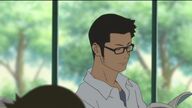This is the time jump; time is irreversible...it happens a lot to girls of Makoto's age...it happened to me. For example, on Sunday, you will sleep late, right? Think 'I don't want to do anything today', right? When I realized it was night, I was surprised.
When Makoto asked "Aunt Witch" who worked in the museum about the strange things that happened to her recently, "Aunt Witch" replied like this. This intentional or unintentional deviation lightly materializes the surreal event of the "time jump", and at the same time suggests a broader "time travel": it is a void in everyday life, a kind of rewind in time. lost. As a result, time jump is no longer just radio wave whimsy, but can be understood as a life state outlined by the sense of time; moreover, this life state is always recognized through "loss". In the film, the loss of daily moments and the passage of time and space to remedy the loss constitute the inner tension of the plot, and finally settle in Konno Makoto's "growth" - passing through - youth.
At first glance, such a plot doesn't seem to detach itself from the cliché of a Bildungsroman: through events, mental upheavals and transformations, the protagonist's mind and character develop, and the story wraps up. However, Makoto's stubbornness towards the lost of the other made it impossible for the story to really reach the end, or in other words, this ending was constantly delayed and entrusted to the "future" of the meeting with Qian Zhaojue.
If we go back along this line of thinking, we can see another narrative thread - a doomed ring that is woven by accident: With the ability to jump in time and space, Makoto escaped disaster, but in disguise it led to the occurrence of Gongsuke and Guosui. A car accident; in exchange for Makoto's last chance to save Gongsuke and Guoho, Qian Zhao used up the number of time and space jumps she had and disappeared into Makoto's world-it seems that the world line will always end, and someone will disappear. Even in the passage of time, Makoto keeps learning lessons and cherishing; the vacancies of the structure can never be filled - this kind of doomed loss cannot be avoided due to growth, cannot be controlled by the growth narrative, and therefore cannot be relieved.
The other side of the growth novel that has not been mentioned emerges here: Growth not only means one-way "development" and "completion", but also runs through the loss that cannot be reduced and surpassed. The tragedy of Makoto's action may lie in this: she travels back and forth again and again, hoping to achieve a happy ending without bias, but each time travel and remedy for bias will always lead to another bias - the problem is, The so-called happy ending can only be imagined as the opposite of loss, and the life course is only given the meaning of “growth” retrospectively as an effort to achieve perfection. In this sense, youth can never be spent - it is always post-photographed.
Perhaps we can use Freud's "sequelae" (Nächkrankheit, also translated as "delayed effect") to understand this backwardness of youth. In Freud's view, sequelae are not simply experiences, impressions and memories left over from the past in the present; on the contrary, it is a "complex series of psychological operations" of the present on the traces of the past, a "reality of previous experience". Rework" [1] . In the continuous return and remodeling, the material of the past is attached with a halo of meaning again and again. Of course, "Not the whole actual experience is reshaped, but only certain events that are not fully integrated into a specific context at the time of the experience are selectively reshaped, and traumatic events are the Paradigm" [2] .
Events that cannot be integrated by the growth narrative, vacancies/lost things that cannot be filled and transcended, constitute youth in memory through such aftereffects; in other words, youth appears only in a delayed manner, and most of the time surrounds Regret and remorse for lost things. This retrospective structure makes youth inherently have a paradox of "vain at that time", and the girl who travels through time and space is also colored with a layer of melancholy.
[1] Shang. Jean Laplanche et al., "Psychoanalytic Glossary" [M]. Translated by Wang Wenji et al., Pedestrian Press. 2000: P40.
[2] Ibid, p37.
View more about The Girl Who Leapt Through Time reviews










